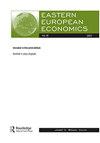用基于螺旋线的综合指标评估国家创新系统的绩效:来自24个欧洲国家的证据
IF 1.2
4区 经济学
Q3 ECONOMICS
引用次数: 2
摘要
本文章由计算机程序翻译,如有差异,请以英文原文为准。
Assessing the Performance of National Innovation Systems with a Helix-Based Composite Indicator: Evidence from 24 European Countries
ABSTRACT We employ the conceptual framework of “N-tuple helices” and devise a composite indicator, namely SFIGA (Society-Finance-Industry-Government-Academia), that aims at measuring the innovation performance of 24 OECD European countries from 2008 to 2017. We also investigate the effects of actors-helices on GDP per capita. The preliminary results from panel data regressions (OLS, quantile, and GMM) indicate their decisive economic importance as key actors of national innovation systems. However, the negative impact of academia on economic growth may explain a highly required resource allocation for basic research in the “knowledge economy” era. Its potential positive economic effects probably require time and patience.
求助全文
通过发布文献求助,成功后即可免费获取论文全文。
去求助
来源期刊

Eastern European Economics
ECONOMICS-
CiteScore
2.20
自引率
9.10%
发文量
32
期刊介绍:
Eastern European Economics publishes original research on the newly emerging economies of Central and Eastern Europe, with coverage of the ongoing processes of transition to market economics in different countries, their integration into the broader European and global economies, and the ramifications of the 2008-9 financial crisis. An introduction by the journal"s editor adds context and expert insights on the articles presented in each issue.
 求助内容:
求助内容: 应助结果提醒方式:
应助结果提醒方式:


